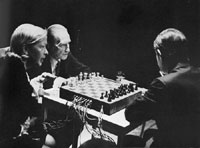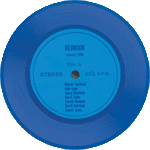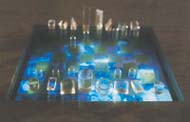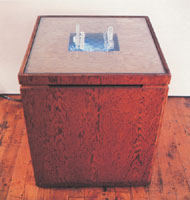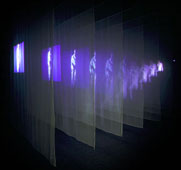|
by Ya-Ling Chen
|
|||||||||||||||||||||||||||||||||||||||||||||||||||||||||||||||||
|
More
Born in Niigata, Japan, in 1937, Shigeko Kubota grew up in a monastic environment during WWII and the subsequent postwar period. She later studied sculpture in Tokyo in the late 1950s and early 1960s, during which Japan strived to reestablish its financial, political and psychological welfare from the devastation of the war. This period also offered a chance for Japanese artists to move away from fairly confined notions of presentation and cultural isolation from the global art community. Although such avant-garde group, as Gutai, began to evoke innovative ideas in the 1950s. For instance, painting by foot, crashing through papers, throwing paint, or displaying water in Osaka and Tokyo, a gender-biased phenomenon was still a fixed hierarchy of the society. After the failure of local art community to put up any critical response to her work, Kubota took off on a Boeing 707, leaving her native country for New York in 1964. She was drawn to the glittering landscape of the New York art scene, where Pop art, Happening, Minimal and Conceptual work were the dominant manners of the time. Through Yoko Ono, she was soon acquainted with George Maciunas, the founder of Fluxus, and became a core member of Fluxus participating in various street events and performances. Fluxus’ rebellious
ideas (Fig. 1) and its multicultural constitution
embraced Kubota and provided her with a nurturing environment to explore
an innovative outlet for her creative impulse. Kubota had learned of
Duchamp and the underlying concepts and intellectual approach of his
work when she was still in Japan and became even more inspired by him
when she visited the Duchamp exhibition by Pontus Hulten at the Stockholm
Museum in 1967. The next year she met Duchamp in person when she was
flying to the opening of Merce Cunningham’s Walk Around Time
(Fig. 2) , a performance based on Duchamp’s
Large Glass (1915-23) with a setting designed by Jasper Johns.
In a lovely story vividly remembered by Kubota:
Despite the newly raised confusion with regard to the sequence of the precise dates for these two events from which an anecdote on the beginning of their friendship is woven,(3) Duchamp had a profound impact on Shigeko Kubota. Not only was he the inspiring father icon for the Fluxus group and for Kubota’s creative impulses, he also offered an unforgettable friendship during the final year of his life. Kubota took part in and photographed Reunion, a chess game organized by John Cage which turned out to be the last public reunion between these two masters of the contemporary creative mind,(4) and it was here that Kubota began to utilize video technology, a novel means through which dream and reality meet. Three works based on this chess event set forth her artist career as a pioneering video artist.
Performed at Ryerson Theatre of Ryerson Polytechnic, Toronto, on March 5, 1968, Reunion was organized by John Cage and included the musicians David Tudor, Gordon Mumma, and David Behrman and a wired-up chessboard designed by Lowell Cross (Fig. 3). When Teeny and Marcel Duchamp took turns playing chess with Cage on the stage, the pre-modulated photoreceptors served as a gating mechanism to receive messages of movements and to transmit sound and light. Depending on the moves of the chess pieces, the sound was cut off or rerouted to generate a kind of random music by means of the pre-configured chance operation of two "intellectual minds." With the photographs she took and material acquired later, Kubota slowly developed three works based on this memorable event: a book, a videotape and a video sculpture in a period of time ranging from 1968 to 1975. Published in 1970 in a limited edition of 500 numbered copies with a blue cover and inserted in a blue cardboard box, Marcel Duchamp and John Cage (Fig. 4) consists of photographs taken during the Reunion performance and a 33 1/3 rpm blue flexidisc (phonograph) of the Reunion sound recording, accompanied by text written by John Cage under the title of "36 Acrostics re. and not re Duchamp."
The videotape of
1972, carring the same title as the book, includes segments of John
Cage--telling stories, mediating, playing a piano, sitting bandaged
while Nam June Paik measures his brain waves (Figs.
5 & 6)--with still images of Teeny, Duchamp and Cage playing
chess in Reunion alternating throughout as though they are the
interlude in music composition. In addition, footage from Kubota's visit
to the graveyard of the Duchamp family in Rouen in 1972
(Fig. 7)(5),
captures the fleeting movement of wind dancing with the patchy light
that pierces through the shadowy grove. A sense of euphoria generates.
On and off for three times, the exotic and shaman-like voice of Kubota
chanting "Marcel Duchamp, 1887 to 1968," is the only literal sound intervening
with the seemingly timeless silence. The life-death confrontation in
an infinite circle is further reinforced through the repetitive expression.
This footage was later edited and colored for Kubota's astounding installation,
Marcel Duchamp's Grave (Fig. 8),
at The Kitchen, New York in 1975.
The concluding work, the Video Chess (1968-75) (Fig. 9), a sculptural TV, is constructed and posited on the floor with its monitor facing up. A transparent chessboard with transparent chess pieces sits above the TV monitor. Kubota reworked the 1968 Toronto photographs by having them transferred, keyed, matted, and colorized at the Experimental TV Center in Binghampton, NY with the assistance of Ken Dominik, and later at WNET-TV Lab in New York. The monitor plays the transferred and colorized images of Duchamp and Cage playing chess with the original soundtrack emitting. Every crosspoint of the chess matrix has a hole and light cell which are modulated by the proceeding of a chess game. As viewers/players look down/play chess on this transparent chessboard, in Kubota's words, they are "accompanied by the videotape of the two great masters playing from the otherside of this world." (6)
Don't The porta-pack
video camera is an integral part of Shigeko Kubota's work, given that
the video camera is to open up a dialogue with the self that is encountered
everyday as well as with unknown natures which are uncovered. Margot
Lovejoy pinpoints the benefit for the presence of the first portable
video camera to the art world:
To Kubota, the unique qualities of video with "no past history, no objecthood, and no agree-upon-value"(9) have set up a new category for equal competition among artists. In a long interview conducted by Katsue Tomiyama in 1991, Kubota praises video because "male and female artists began the competition at an equal point." (10) Her attraction to the video, furthermore, is educed by its "oriental" and "organic" nature--"like brown rice, brown curb, like seaweed, made in Japan." (11)--the single-channel TV is capable of bridging two extreme worlds--"TV is always somewhere between dream and reality." (12) She later contemplates, "video acts as an extension of the brain's memory cells. Therefore, life with video is like living with two brains, one plastic brain and one organic brain. One's life is inevitably altered. Change will effect even our relationship with death, as video is a living altar. Yes, videotaped death negates death as a simple terminal."(13)
Closely examining these three works, one can tell the apparent contrast between the independence of individual segments seen in the blue book (1968-72) as well as in the videotape (1972), and the integration of Video Chess (1968-75) as the sculptural entity. The 1972 videotape of Marcel Duchamp and John Cage in which fragments of images alternate with one another, barely has the trace of editing revealed. In the 1991 interview, Kubota admitted her reluctance to alter the video-recorded images, which is coherent with what we see in the 1972 videotape, an open-ended quality register with a sense of naivety. On the contrary, Video Chess is eloquently constructed and presented under an authoritative art form. This time, Kubota ruminates on the overall presentation as a whole as oppose to co-existing fragments presented in the prior video of Marcel Duchamp and John Cage. The conceptual connection is reinforced by the absence of both intellectual minds. In other words, the absence of both Cage and Duchamp has turned into an abstract physicality. The spectator can only be aware of their presence by the arbitrary appropriation offered by Shigeko Kubota. It is as if she is the invisible and all-powerful shaman who channels and embodies the men-objects with our living world in a simulated territory where life and death negate each other, forming an endless cycle.
During visit to Duchamp's grave, the ritual act of presenting an offering (her blue book) on Duchamp's grave and chanting was "as in the oriental family custom of putting rice cookies on the dead ancestor's altar."(15) Usually performed by an official in ancient estern culture, chanting during the funeral rite is regarded as the emotional mourning toward the loss of loved ones and a communication with them on the other side of the world. Aesthetically, the poetic and exquisite elaboration of Video Chess is quite appealing and from this Kubota would further mature as an original and independent video artist and become a significant figure among her peers, such as Nam June Paik (Fig. 11), Peter Campus (Fig. 12), Bill Viola (Fig. 13), Gary Hill, and Dan Graham, who together mark the first phase of Video Art. However, not so much to deduce the conceptual connection between Kubota's Japanese and Duchampian "roots," (16) her ability to integrate personal memories and history into an exquisite sensibility substantiates Kubota's identity as a female artist who tackles motifs rooted in art and life and elevates them to the hegemonic discourse of art history. To Kubota, art making is always something deeply associated with nature and culture alike. In the case of these three works derived from the chess Reunion, the materialization of Duchamp and Cage is appropriated and manipulated by Kubota. The search for truthful perceptions of history, perhaps, is best summed up by Kubota's self-description for her video sculpture Adam and Eve of 1991. An environmental work drawn on Kubota's friendship with Al Robbins and the influence by which Duchamp palyed Adam with Brogna Perlmutter as Eve in Picabia's Relâche (1926), a ballet work inspired by Lucas Cranach's painting, Adam and Eve is "an appropriation of an appropriation of an appropriation of an appropriation."(17) From this perspective, the duality between subject and object has been erased because it no longer represents authenticity but a repetition of the past.
Notes
Fig.
2 ©
Merce Cunningham Dance Foundation, Inc., NY, 2002
|
|||||||||||||||||||||||||||||||||||||||||||||||||||||||||||||||||
